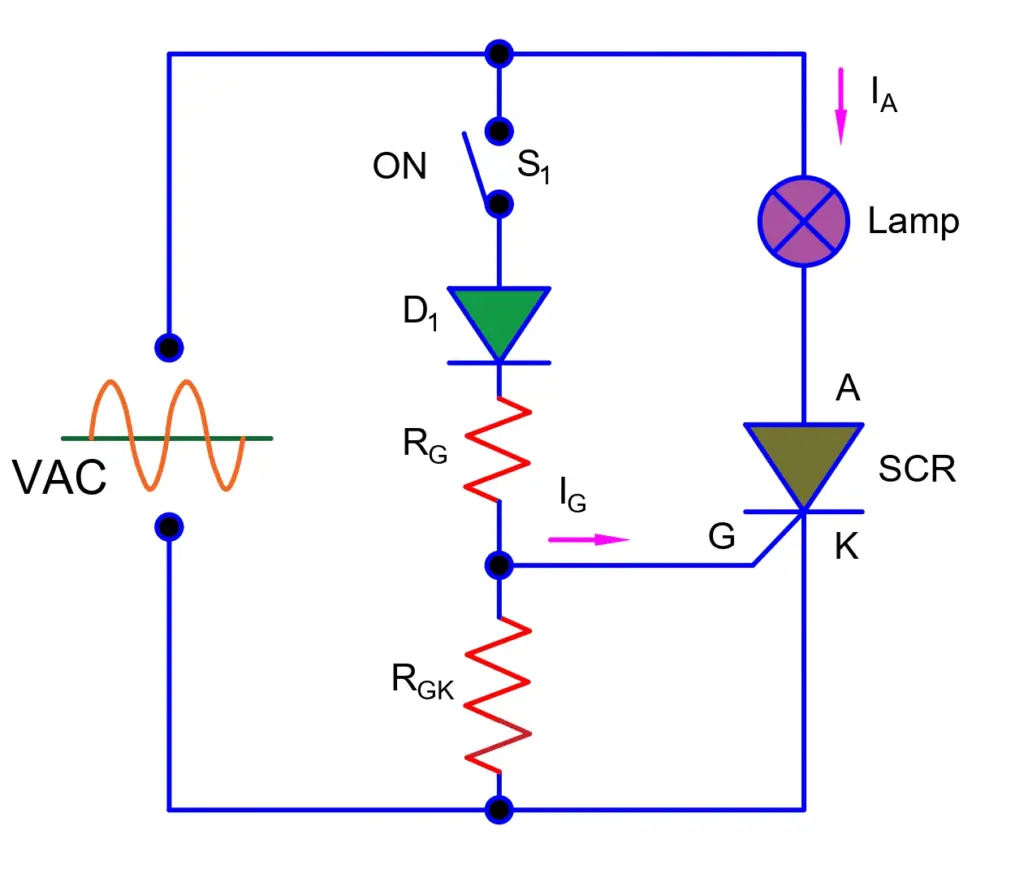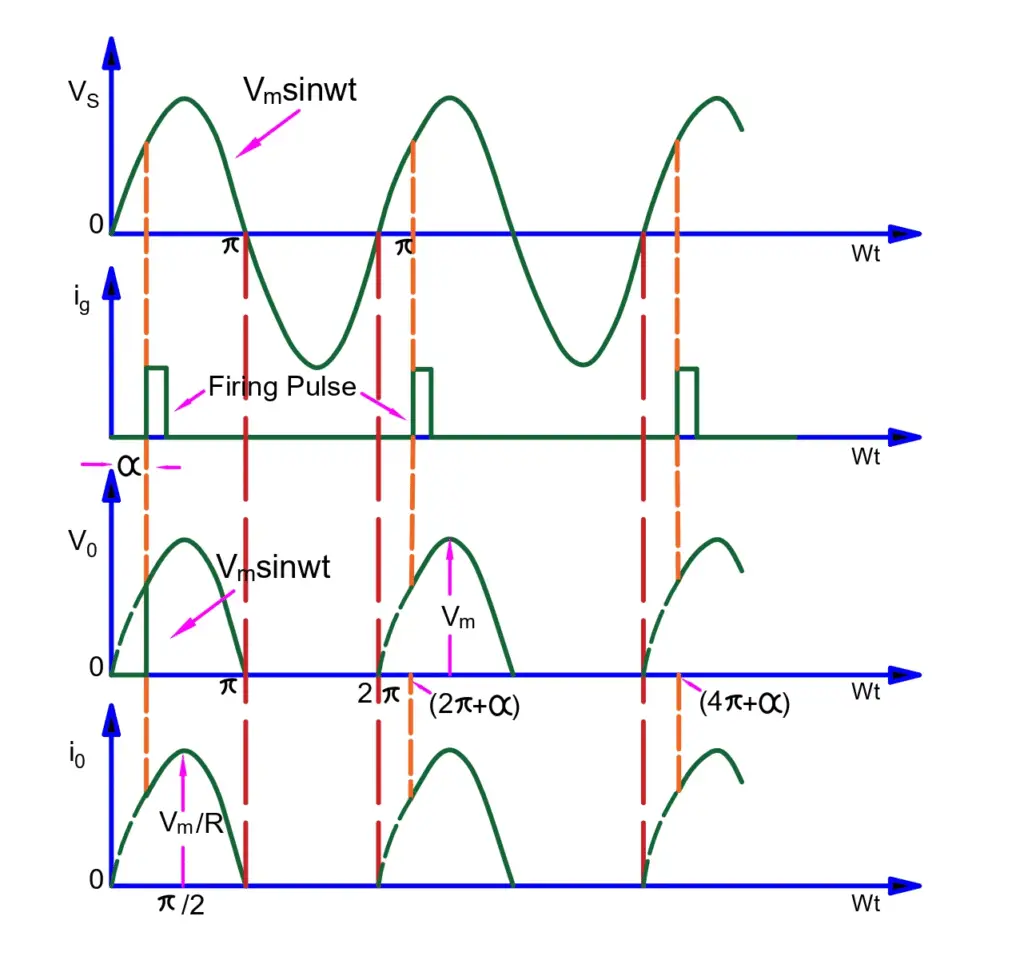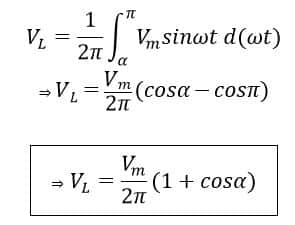Firing angle of SCR is the angle after which the thyristor conducts. Power electronic devices or switches in control applications are known for their efficient working and less power consumption compared to traditional methods where we made use of rheostats or shunts to control voltage or current-dependent parameters. One such power electronics device is SCR or Silicon Controlled Rectifier.
Silicon Controlled Rectifier (SCR) also known as Thyristor is a three-terminal semiconductor device which is used in various applications like speed control of a motor. The three terminals are ANODE, CATHODE and GATE as shown below.

The device working principle is the same as that of a P-N junction diode. The only difference is the availability of a GATE terminal in the SCR which must be supplied in order to allow the SCR to conduct. The gate terminal is supplied with adequate voltage supply at a particular instance of time which in angular terms is referred to as the firing angle. Let’s understand about firing angle in detail.
Firing angle in an SCR
Let’s consider an electrical load is supplied with an AC supply connected in series with a P-N junction diode. As a result, the diode being forward biased will conduct for the entire positive half of a cycle while it will be reverse biased for the negative half and will stop conduction. Thus, the load will receive power only during the positive half of the AC supply. In this way, the diode rectifies the input AC to DC.
The SCR or Thyristor works on the same principle except for the fact that even after being forward-biased, it conducts only when the gate terminal is supplied with an appropriate voltage.
Thus, for the positive half cycle of the AC supply, the SCR remains forward-biased. At a certain instant of time, the gate terminal is supplied which causes the SCR to conduct.
The advantage is that while we have no control over the average voltage output from the diode as it conducts for the complete half cycle, with SCR we can control the output voltage by supplying the gate terminal at an appropriate instant of time within the positive half cycle.
This supplying of the gate current to the gate terminal is known as gate-firing of the SCR and the instant of time at which the gate is fired is known as the firing angle.
The term ‘angle’ is used to denote the angle at which the AC waveform remains at the given instant of time. Let’s understand with the help of a mathematical model.
Mathematical analysis of firing angle

The circuit diagram shown above is that of a load connected to an AC supply through an SCR. Here the load is a lamp as shown. Now, during the positive half cycle of the AC supply, the SCR gets forward-biased as the anode A and the cathode K are connected to the positive and negative voltage terminals respectively.
Even though the SCR is forward-biased, it doesn’t allow conduction as its gate terminal has not been supplied. To allow conduction through the SCR, switch S1 is closed thus allowing a suitable current to flow to the gate terminal. RG and RGk are the gate voltage limiting resistance as the required voltage required for triggering (i.e, activating or supplying) the gate terminal is very small. The diode D1 ensures that a positive trigger voltage appears at the gate terminal.
Now, at a particular instant of time let’s say t1, the switch S1 is closed and thus the SCR begins to conduct. The SCR will therefore keep on conducting for the duration from the instant t1 till the end of the positive half cycle. The figure given below is that of the source AC voltage. The shaded region within the positive half-cycles represent the duration for which the SCR conducts.

The instantaneous voltage of the source is given as

The firing angle is denoted by α as shown in the waveform. This firing angle is the angular representation of the instant at which the SCR gate is triggered i.e, t1.
Now let us put all these things in perspective. Let say I want to activate the circuit at the instantaneous voltage V1. So, we need to calculate the required firing angle corresponding to this voltage.
Therefore,

Where α is the firing angle at the instant when the instantaneous voltage reaches V1. So, the firing angle α will be ;

Let’s understand this all with the help of an example. Let’s assume the SCR in the above given circuit to start conducting when the instantaneous voltage reaches its maximum value. What will be the firing angle? Let’s calculate
So, in this scenario

Therefore, the firing angle is

Therefore, the firing angle to activate the SCR at maximum source voltage is 90 degrees. But how are we going to make use of this angle in the circuit? For that we have to know the time instant at which the voltage waveform reaches 90 degrees i.e, the point of maximum voltage.
Therefore, we put 90 degrees value in the equation of source instantaneous voltage in order to obtain the corresponding time instant.
So,

Therefore,

Assuming the source voltage frequency, f = 50Hz or 50 cycles/sec., we get

Thus, to allow the SCR to start conduction at peak or maximum voltage, we have to trigger it at a firing angle of 90 degrees. To do that, we have to close the gate trigger switch S1 (in the circuit given above) after 5 milliseconds each time in the positive half-cycle of the voltage waveform.
However, this switching is not done physically as it is not possible to trigger the gate terminal within 5ms physically. Thus, a triggering circuit like an RC circuit is employed which can generate a positive pulse at every 5ms as the source voltage waveform enters in its positive half-cycle.
During the negative half-cycle, the SCR remains reverse biased and doesn’t conduct even if the gate is triggered.
This is all about firing angle in an SCR.
Calculation of load voltage with respect to firing angle of the SCR
Now, you must be wondering what is the advantage of all this? What purpose does the firing of the SCR serve? The answer is: smooth and efficient voltage control.
Now, in the waveform given above, the SCR starts conducting at the firing angle ωt= α and continues to conduct till ωt= π for one complete cycle from 0 to 2 π. Therefore, the average load voltage is ;

Thus, by knowing the value of firing angle, we can calculate the average load voltage. For our example, α = 900 and Vm= 220 X√2, assuming the RMS voltage is 220V. So, the average load voltage is;

Thus, we have controlled the voltage in our load to 49.54V only that too efficiently. While this can be done using resistors as well but that would lead to enormous power loss across the resistor. Whereas in case of SCR, the voltage drop is very small across it (0.7~1V). This is the advantage of using an SCR.